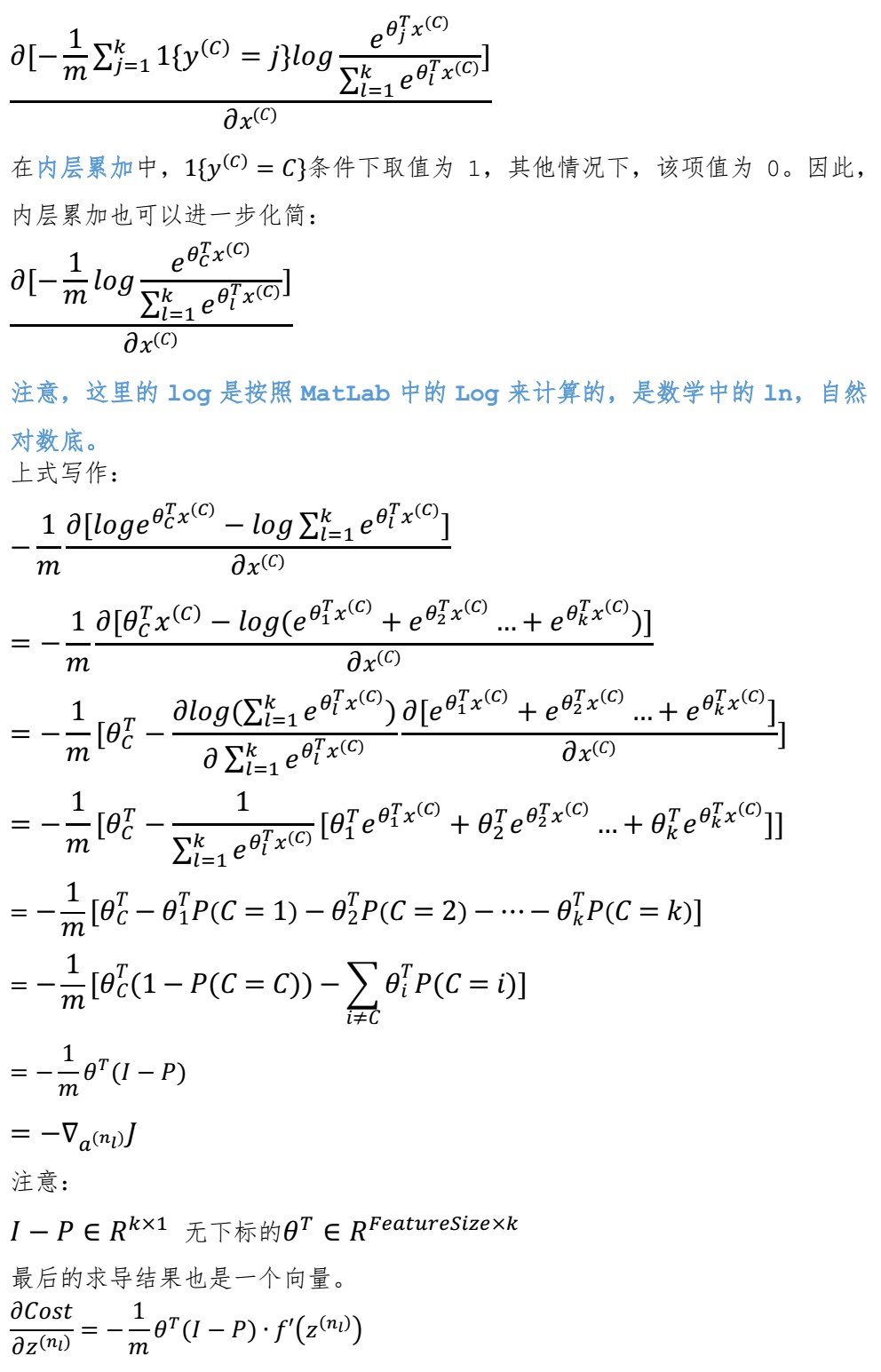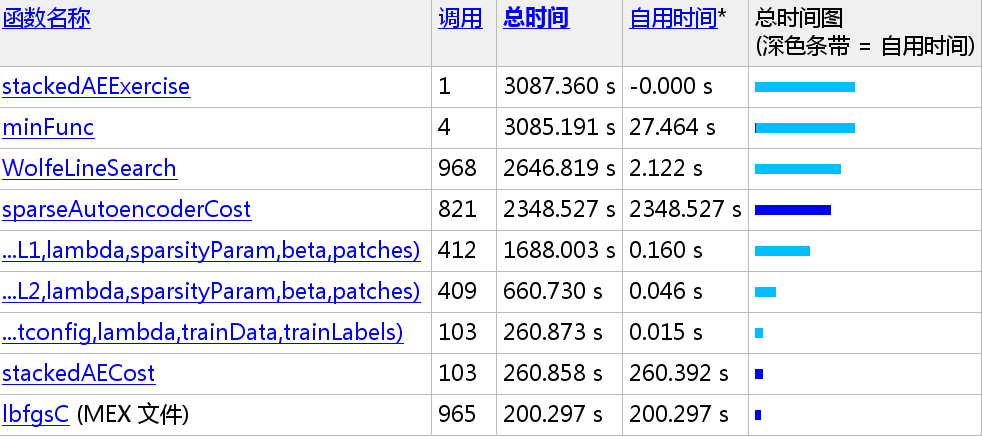{作为CNN学习入门的一部分,笔者在这里逐步给出UFLDL的各章节Exercise的个人代码实现,供大家参考指正}
理论部分可以在线参阅(页面最下方有中文选项)Self-Taught Learning to Deep Networks到Fine-tuning Stacked AEs部分内容
但大部分推导都可以在在线参阅的内容Fine-tuning Stacked AEs中找到,这里只给出对输出层error term求导的证明:
stackedAeCost.m
function [ cost, grad ] = stackedAECost(theta, inputSize, hiddenSize, ...
numClasses, netconfig, ...
lambda, data, labels)
% stackedAECost: Takes a trained softmaxTheta and a training data set with labels,
% and returns cost and gradient using a stacked autoencoder model. Used for
% finetuning.
% theta: trained weights from the autoencoder
% visibleSize: the number of input units
% hiddenSize: the number of hidden units *at the 2nd layer*
% numClasses: the number of categories
% netconfig: the network configuration of the stack
% lambda: the weight regularization penalty
% data: Our matrix containing the training data as columns. So, data(:,i) is the i-th training example.
% labels: A vector containing labels, where labels(i) is the label for the
% i-th training example
%% Unroll softmaxTheta parameter
% We first extract the part which compute the softmax gradient
softmaxTheta = reshape(theta(1:hiddenSize*numClasses), numClasses, hiddenSize);
% Extract out the "stack"
stack = params2stack(theta(hiddenSize*numClasses+1:end), netconfig);
% You will need to compute the following gradients
softmaxThetaGrad = zeros(size(softmaxTheta));
stackgrad = cell(size(stack));
for d = 1:numel(stack)
stackgrad{d}.w = zeros(size(stack{d}.w));
stackgrad{d}.b = zeros(size(stack{d}.b));
end
% cost = 0; % You need to compute this
% You might find these variables useful
numCases = size(data, 2);
groundTruth = full(sparse(labels, 1:numCases, 1));
%% --------------------------- YOUR CODE HERE -----------------------------
% Instructions: Compute the cost function and gradient vector for
% the stacked autoencoder.
%
% You are given a stack variable which is a cell-array of
% the weights and biases for every layer. In particular, you
% can refer to the weights of Layer d, using stack{d}.w and
% the biases using stack{d}.b . To get the total number of
% layers, you can use numel(stack).
%
% The last layer of the network is connected to the softmax
% classification layer, softmaxTheta.
%
% You should compute the gradients for the softmaxTheta,
% storing that in softmaxThetaGrad. Similarly, you should
% compute the gradients for each layer in the stack, storing
% the gradients in stackgrad{d}.w and stackgrad{d}.b
% Note that the size of the matrices in stackgrad should
% match exactly that of the size of the matrices in stack.
%
% Gradient Check : 1.0932e-11
%
% ================= Cost =================
% Stack Layer
activation_L1 = 1 ./ (1 + exp(-bsxfun(@plus, stack{1}.w*data, stack{1}.b)));
activation_L2 = 1 ./ (1 + exp(-bsxfun(@plus, stack{2}.w*activation_L1, stack{2}.b)));
sae2Features = activation_L2;
% Softmax Layer
M = softmaxTheta * sae2Features; % M(r,c) is theta.T.r*x(:,c)
M = bsxfun(@minus, M, max(M, [], 1)); % Preventing overflows.
M = exp(M);
M = bsxfun(@rdivide, M, sum(M)); % Dividing all elements in each column by their column sum.
J_theta = sum(sum(log(M).*groundTruth));
J_theta = -J_theta / numCases;
WeightDecay = lambda * sum(sum(softmaxTheta.^2)) / 2;
cost = J_theta + WeightDecay;
% ================= Gradient =================
% Stack Layer
M = groundTruth - M;
Gradient_J = softmaxTheta' * (M);
MatrixDelte_L2 = -Gradient_J/numCases .* activation_L2 .* (1 - activation_L2);
MatrixDelte_L1 = ((stack{2}.w)' * MatrixDelte_L2) .* activation_L1 .* (1 - activation_L1);
stackgrad{1}.w = MatrixDelte_L1 * data';
stackgrad{1}.b = sum(MatrixDelte_L1, 2);
stackgrad{2}.w = MatrixDelte_L2 * activation_L1';
stackgrad{2}.b = sum(MatrixDelte_L2, 2);
% Softmax Layer
for i = 1:1:numClasses
softmaxThetaGrad(i,:) = sum(bsxfun(@times, activation_L2, M(i,:)), 2); % Array multiply
end
softmaxThetaGrad = -softmaxThetaGrad/numCases + lambda * softmaxTheta;
% -------------------------------------------------------------------------
%% Roll gradient vector
grad = [softmaxThetaGrad(:) ; stack2params(stackgrad)];
end
%% CS294A/CS294W Stacked Autoencoder Exercise
% Instructions
% ------------
%
% This file contains code that helps you get started on the
% sstacked autoencoder exercise. You will need to complete code in
% stackedAECost.m
% You will also need to have implemented sparseAutoencoderCost.m and
% softmaxCost.m from previous exercises. You will need the initializeParameters.m
% loadMNISTImages.m, and loadMNISTLabels.m files from previous exercises.
%
% For the purpose of completing the assignment, you do not need to
% change the code in this file.
%
%%======================================================================
%% STEP 0: Here we provide the relevant parameters values that will
% allow your sparse autoencoder to get good filters; you do not need to
% change the parameters below.
inputSize = 28 * 28;
numClasses = 10;
hiddenSizeL1 = 200; % Layer 1 Hidden Size
hiddenSizeL2 = 200; % Layer 2 Hidden Size
sparsityParam = 0.1; % desired average activation of the hidden units.
% (This was denoted by the Greek alphabet rho, which looks like a lower-case "p",
% in the lecture notes).
lambda = 3e-3; % weight decay parameter
beta = 3; % weight of sparsity penalty term
magnitude = 100; % magnitude of iteration
%%======================================================================
%% STEP 1: Load data from the MNIST database
%
% This loads our training data from the MNIST database files.
% Load MNIST database files
trainData = loadMNISTImages('mnist/train-images.idx3-ubyte');
trainLabels = loadMNISTLabels('mnist/train-labels.idx1-ubyte');
trainLabels(trainLabels == 0) = 10; % Remap 0 to 10 since our labels need to start from 1
%%======================================================================
%% STEP 2: Train the first sparse autoencoder
% This trains the first sparse autoencoder on the unlabelled STL training
% images.
% If you've correctly implemented sparseAutoencoderCost.m, you don't need
% to change anything here.
% Randomly initialize the parameters
sae1Theta = initializeParameters(hiddenSizeL1, inputSize);
%% ---------------------- YOUR CODE HERE ---------------------------------
% Instructions: Train the first layer sparse autoencoder, this layer has
% an hidden size of "hiddenSizeL1"
% You should store the optimal parameters in sae1OptTheta
patches = trainData;
% Use minFunc to minimize the function
addpath minFunc/
options.Method = 'lbfgs'; % Here, we use L-BFGS to optimize our cost
% function. Generally, for minFunc to work, you
% need a function pointer with two outputs: the
% function value and the gradient. In our problem,
% sparseAutoencoderCost.m satisfies this.
options.maxIter = 4 * magnitude; % Maximum number of iterations of L-BFGS to run
options.display = 'on';
[sae1OptTheta, cost] = minFunc( @(p) sparseAutoencoderCost(p, ...
inputSize, hiddenSizeL1, ...
lambda, sparsityParam, ...
beta, patches), ...
sae1Theta, options);
% -------------------------------------------------------------------------
%%======================================================================
%% STEP 2: Train the second sparse autoencoder
% This trains the second sparse autoencoder on the first autoencoder
% featurse.
% If you've correctly implemented sparseAutoencoderCost.m, you don't need
% to change anything here.
[sae1Features] = feedForwardAutoencoder(sae1OptTheta, hiddenSizeL1, ...
inputSize, trainData);
% Randomly initialize the parameters
sae2Theta = initializeParameters(hiddenSizeL2, hiddenSizeL1);
%% ---------------------- YOUR CODE HERE ---------------------------------
% Instructions: Train the second layer sparse autoencoder, this layer has
% an hidden size of "hiddenSizeL2" and an inputsize of
% "hiddenSizeL1"
%
% You should store the optimal parameters in sae2OptTheta
patches = sae1Features;
% Use minFunc to minimize the function
addpath minFunc/
options.Method = 'lbfgs'; % Here, we use L-BFGS to optimize our cost
% function. Generally, for minFunc to work, you
% need a function pointer with two outputs: the
% function value and the gradient. In our problem,
% sparseAutoencoderCost.m satisfies this.
options.maxIter = 4 * magnitude; % Maximum number of iterations of L-BFGS to run
options.display = 'on';
[sae2OptTheta, cost] = minFunc( @(p) sparseAutoencoderCost(p, ...
hiddenSizeL1, hiddenSizeL2, ...
lambda, sparsityParam, ...
beta, patches), ...
sae2Theta, options);
% -------------------------------------------------------------------------
%%======================================================================
%% STEP 3: Train the softmax classifier
% This trains the sparse autoencoder on the second autoencoder features.
% If you've correctly implemented softmaxCost.m, you don't need
% to change anything here.
[sae2Features] = feedForwardAutoencoder(sae2OptTheta, hiddenSizeL2, ...
hiddenSizeL1, sae1Features);
% Randomly initialize the parameters
saeSoftmaxTheta = 0.005 * randn(hiddenSizeL2 * numClasses, 1);
%% ---------------------- YOUR CODE HERE ---------------------------------
% Instructions: Train the softmax classifier, the classifier takes in
% input of dimension "hiddenSizeL2" corresponding to the
% hidden layer size of the 2nd layer.
%
% You should store the optimal parameters in saeSoftmaxOptTheta
%
% NOTE: If you used softmaxTrain to complete this part of the exercise,
% set saeSoftmaxOptTheta = softmaxModel.optTheta(:);
lambda = 1e-4;
options.maxIter = 1 * magnitude;
softmaxModel = softmaxTrain(hiddenSizeL2, numClasses, lambda, ...
sae2Features, trainLabels, options);
saeSoftmaxOptTheta = softmaxModel.optTheta(:);
% -------------------------------------------------------------------------
%%======================================================================
%% STEP 5: Finetune softmax model
% Implement the stackedAECost to give the combined cost of the whole model
% then run this cell.
% Initialize the stack using the parameters learned
stack = cell(2,1);
stack{1}.w = reshape(sae1OptTheta(1:hiddenSizeL1*inputSize), ...
hiddenSizeL1, inputSize);
stack{1}.b = sae1OptTheta(2*hiddenSizeL1*inputSize+1:2*hiddenSizeL1*inputSize+hiddenSizeL1);
stack{2}.w = reshape(sae2OptTheta(1:hiddenSizeL2*hiddenSizeL1), ...
hiddenSizeL2, hiddenSizeL1);
stack{2}.b = sae2OptTheta(2*hiddenSizeL2*hiddenSizeL1+1:2*hiddenSizeL2*hiddenSizeL1+hiddenSizeL2);
% Initialize the parameters for the deep model
[stackparams, netconfig] = stack2params(stack);
stackedAETheta = [ saeSoftmaxOptTheta ; stackparams ];
%% ---------------------- YOUR CODE HERE ---------------------------------
% Instructions: Train the deep network, hidden size here refers to the '
% dimension of the input to the classifier, which corresponds
% to "hiddenSizeL2".
%
%
[stackedAEOptTheta, cost] = minFunc( @(p) stackedAECost(p, ...
inputSize, hiddenSizeL2, ...
numClasses, netconfig, ...
lambda, trainData, trainLabels), ...
stackedAETheta, options);
% -------------------------------------------------------------------------
%%======================================================================
%% STEP 6: Test
% Instructions: You will need to complete the code in stackedAEPredict.m
% before running this part of the code
%
% Get labelled test images
% Note that we apply the same kind of preprocessing as the training set
testData = loadMNISTImages('mnist/t10k-images.idx3-ubyte');
testLabels = loadMNISTLabels('mnist/t10k-labels.idx1-ubyte');
testLabels(testLabels == 0) = 10; % Remap 0 to 10
[pred] = stackedAEPredict(stackedAETheta, inputSize, hiddenSizeL2, ...
numClasses, netconfig, testData);
acc = mean(testLabels(:) == pred(:));
fprintf('Before Finetuning Test Accuracy: %0.3f%%\n', acc * 100);
[pred] = stackedAEPredict(stackedAEOptTheta, inputSize, hiddenSizeL2, ...
numClasses, netconfig, testData);
acc = mean(testLabels(:) == pred(:));
fprintf('After Finetuning Test Accuracy: %0.3f%%\n', acc * 100);
% Accuracy is the proportion of correctly classified images
% The results for our implementation were:
%
% Before Finetuning Test Accuracy: 87.7%
% After Finetuning Test Accuracy: 97.6%
%
% If your values are too low (accuracy less than 95%), you should check
% your code for errors, and make sure you are training on the
% entire data set of 60000 28x28 training images
% (unless you modified the loading code, this should be the case)
function [pred] = stackedAEPredict(theta, inputSize, hiddenSize, numClasses, netconfig, data)
% stackedAEPredict: Takes a trained theta and a test data set,
% and returns the predicted labels for each example.
% theta: trained weights from the autoencoder
% visibleSize: the number of input units
% hiddenSize: the number of hidden units *at the 2nd layer*
% numClasses: the number of categories
% data: Our matrix containing the training data as columns. So, data(:,i) is the i-th training example.
% Your code should produce the prediction matrix
% pred, where pred(i) is argmax_c P(y(c) | x(i)).
%% Unroll theta parameter
% We first extract the part which compute the softmax gradient
softmaxTheta = reshape(theta(1:hiddenSize*numClasses), numClasses, hiddenSize);
% Extract out the "stack"
stack = params2stack(theta(hiddenSize*numClasses+1:end), netconfig);
%% ---------- YOUR CODE HERE --------------------------------------
% Instructions: Compute pred using theta assuming that the labels start
% from 1.
activation_L1 = 1 ./ (1 + exp(-bsxfun(@plus, stack{1}.w*data, stack{1}.b)));
activation_L2 = 1 ./ (1 + exp(-bsxfun(@plus, stack{2}.w*activation_L1, stack{2}.b)));
sae2Features = activation_L2;
M = softmaxTheta * sae2Features;
[argmax_c_value_Vec, argmax_c_index_Vec] = max(M, [], 1);
pred = argmax_c_index_Vec;
% -----------------------------------------------------------
end
笔者在实验中采用的迭代轮数为:
两个Sparse AutoEncoder Layer 迭代400次
Softmax Layer 迭代100次
Fine-tunning 迭代100次
权重损失系数:
AutoEncoder Layer 3e-3
Softmax Layer 1e-4
Fine-tunning 1e-4
可能由于系数选择的不同以及迭代次数的差异,笔者的实验结果与benchmark有较大差异:
Benchmark为:
87.7%
97.6%
注:
笔者在softmax层的迭代时,并没有完成100次迭代就达到了精度:
给出大致耗时的估计:
笔者(i7-5500U 16G Maximum Performance):3087.360/60 = 51.456 mins
Maximum Memory Consumption : About 4.5 GB




























 754
754











 被折叠的 条评论
为什么被折叠?
被折叠的 条评论
为什么被折叠?








